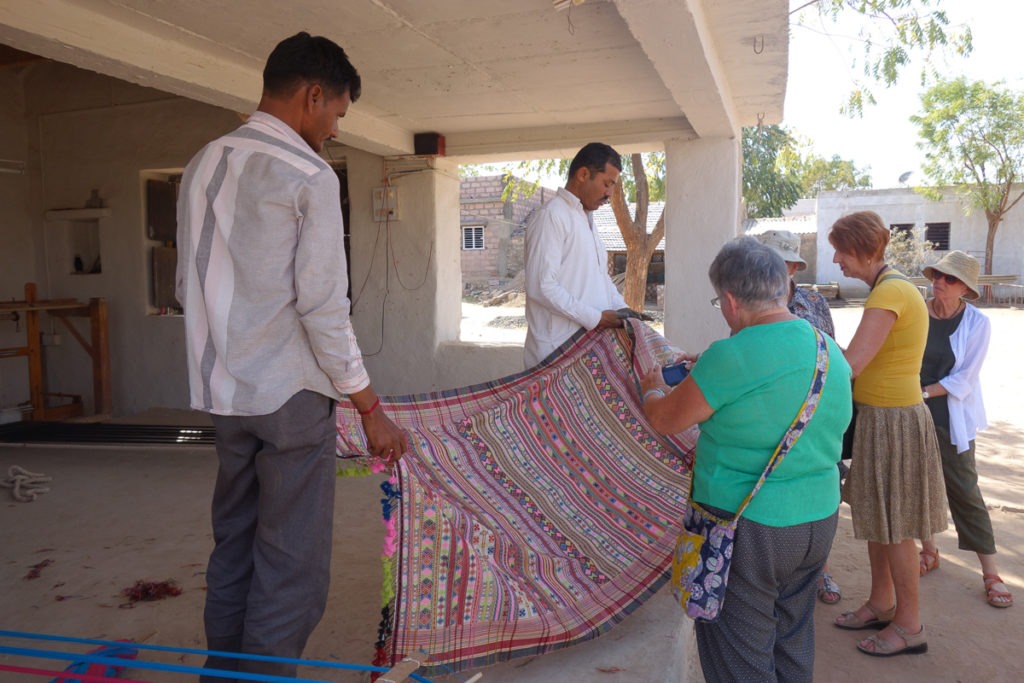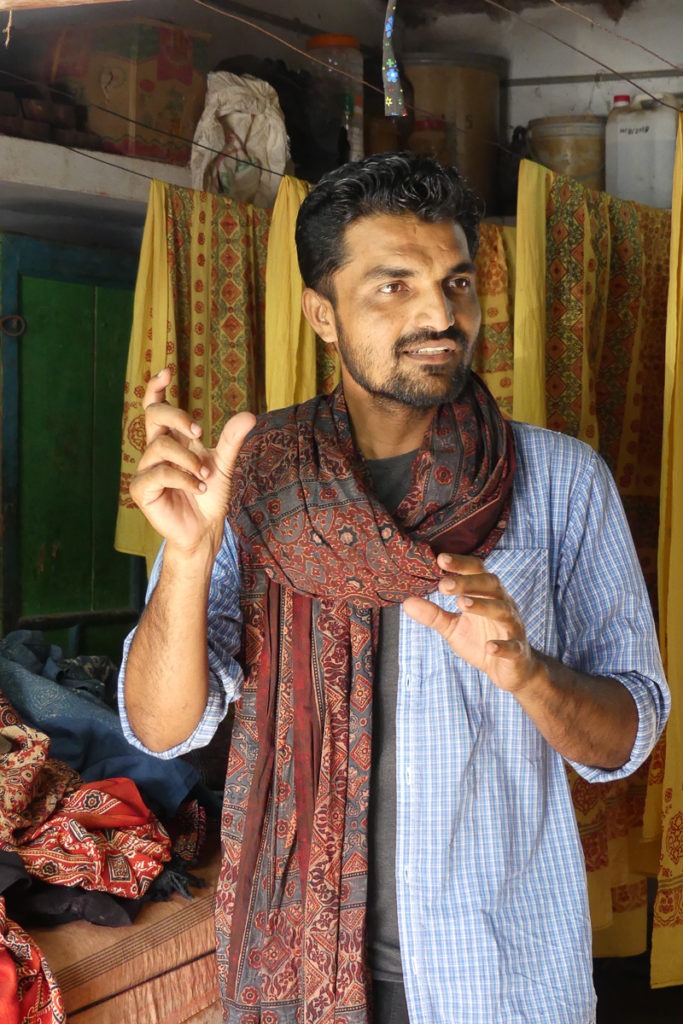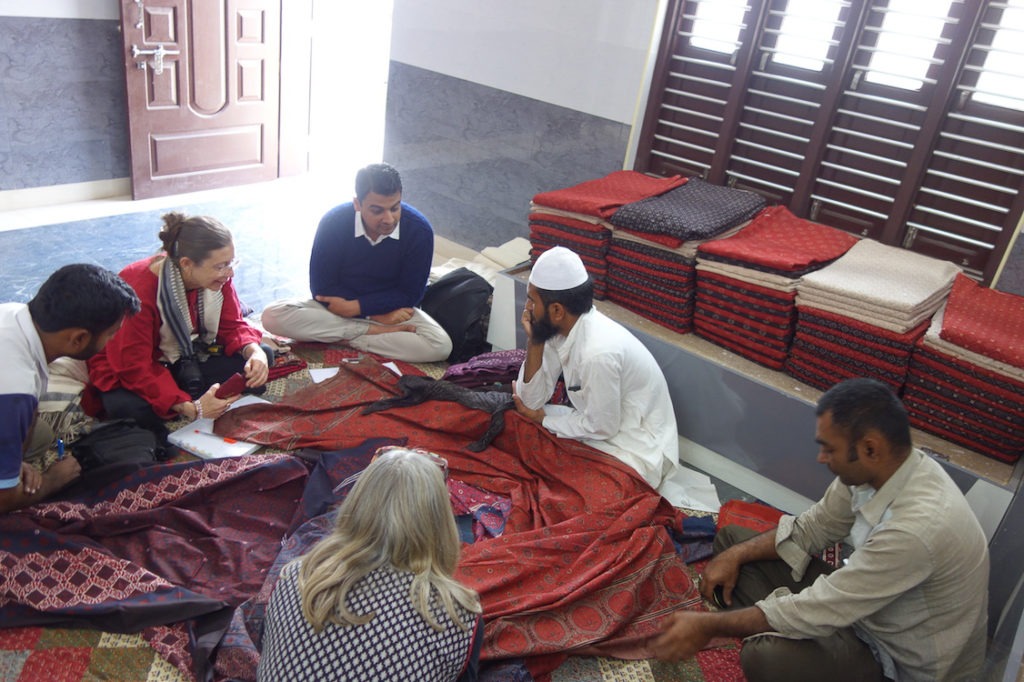
Master Weaver Shamji Vishram Valji showing a traditional dhablo to a tour group run by Carole Douglas of Desert Traditions, and guided by Nirav Panchal in 2017. Photograph: Ruth Clifford
Ruth Clifford shares her advice about key issues in visiting craftspersons and offers a variety of alternative models for experiencing their remarkable skills.
Crafts form an important part of the cultural identity, economy and social life of Kutch. Kutchi villages—home to weavers, block printers, bandhani (tie-dye), batik artisans and embroiderers, copper bell makers, leather artisans and potters—have become popular destinations for visitors seeking to escape from busy city life or learn more about age-old craft practices.
Historically, craft was mostly done for local clients on a part-time basis alongside agriculture, for ceremonial purposes and in the case of embroidery, for a woman’s dowry or to mark important rituals and life stages. However, with commercialisation craft has become the sole form of income for many artisans, several of whom have found success selling to urban and global markets.
Tourism in Kutch: Benefits and challenges
Kutch has become an increasingly popular tourist destination, particularly since the aftermath of the devastating earthquake that hit the region in 2001, when funds were injected for its regeneration, and the government gave businesses a five-year tax holiday. Industries including cement, power, a large port and tourism boomed, and non-governmental and charitable organisations received funds to support the more traditional, mostly domestic craft industry.
During the high season from November to March, many visitors come to villages like Bhujodi (home to a large number of weavers) and Ajrakhpur (“place of ajrakh”, a style of block printing distinct to the region). While tourism is economically beneficial for craftspeople, it also brings several challenges.
Often, visitors simply turn up on the doorstep of an artisan’s home without advance notice. This is disruptive to artisans’ daily schedule, and when an artisan family’s workspace is shared with their home space it can also be intrusive. Because the people of Kutch are naturally hospitable and welcoming, they don’t turn visitors away. However, it is important for visitors to remember that they are visiting homes, not heritage sites, village replicas or centres erected specially for tourism.
Some artisans have come up with shrewd ways of managing visitors. Renowned master block printer Ismail Mohammed Khatri has built a museum and demonstration centre separate to his home in Ajrakhpur village. Master weaver Shamji Vishrambhai Valji is planning on turning his Bhujodi home into something similar and moving his family home away from the main street that tourists pass through. These demonstration centres give visitors the opportunity to experience the several processes involved in making an ajrakh or a handloomed textile, something artisans say helps visitors to appreciate the craft better and understand its value. The increase in large glitzy handicraft shops in Bhuj and the exhibition at Rann Utsav (desert festival) which occurs every winter in northern Kutch, feature much cheaper versions of crafts, including machine-made imitations, which undermines the value and integrity of products made by artisans and their ancestors over many generations. Such competition makes Bhujodi carpet weaver Prakash Naranbhai Siju concerned for the future of artisans who are continuing traditional processes.
Craft tours
Craft tours led by local, knowledgeable experts are another way to manage visitors and ensure artisans are prepared for their visit.
Kuldip Gadhvi is a charismatic local tour guide, who won the World Responsible Tourism award in 2014 for his passion for looking after Kutch’s people and landscape. He bemoans mass-production of crafts and mass-tourism.
“It’s a pity that many textile and craft lovers who spend a lot of money visiting Kutch to learn more about the source of particular textiles end up in big shops and studios, when they could have chosen to meet a real artisan in person, listen to their story, craft history, cultural, economic and social circumstances,” he says.
Gadhvi founded United Artisans of Kutch, which links lesser-known artisans with the network of contacts he has built over several years working as a tour guide in Kutch. He also provides responsible tourism guidelines to avoid negative social as well as environmental impact, citing the significant pressures of increased tourism and other industries on the environment, particularly Kutch’s scarce water sources.
Judy Frater is the director of Somaiya Kala Vidya (SKV), a local institute which provides a year-long educational programme in design for traditional artisans. More recently, Frater has begun leading Open Studio Tours, which allow visitors to meet graduates of the institute who are innovating within the traditional repertoire of their craft in weaving, block printing and natural dyeing. Recognised by Conde Nast Traveller India, the tours are conducted in Bhujodi and Ajrakhpur, visitors are provided with a map showing the home/workplaces of participating artisan designers, explore the village and then have lunch at the home of a designated artisan-designer.
Leila Walter attended the tour. “The tours create an opportunity for tourists and textile enthusiasts to engage with artisans and learn the processes without disturbing them from their work,” she says.
Carpet weaver and SKV graduate Prakash Naranbhai Siju is one artisan engaging with the tours. He believes the trips are easier to fit into his schedule.
“Because they are fully organised, we can prepare our workshops and prepare mentally for the group’s visit,” he says.
When Prakash receives visitors unannounced—who are often keen to see every process of his weaving—he finds it difficult to organise properly and says it can interrupt his workflow. Despite this, he welcomes all visitors.
“We enjoy having visitors because they take our craft and culture with them in their memories, and they are supporting the craft,” says Prakash.

Open Studio Tour with weavers Prakash Naranbhai Siju and Pachan Premjibhai Siju, January 2020, photo: Judy Frater
While Bhuj is home to many hotels, homestays are a welcome alternative for the responsible tourist.
Bhuj House, a renovated heritage house is one such homestay in the lesser-known area of Camp and attracts people coming to learn about Kutch crafts and textiles. Its owner, Katie Bhujwala, says she has seen “some of the most reserved ‘other-halves’ of visiting couples get completely blown away by the intricate techniques that you can witness taking place in an artisan’s home.”
Craft courses and workshops
SKV also organises craft workshops and courses in handloom extra-weft weaving, hand block printing, batik block printing, bandhani (tie-dye), and dyeing with synthetic and natural dyes. Kutchi embroidery, which is different depending on the community, is also taught.
The workshops give textile enthusiasts, designers and students the opportunity to learn the craft not only by observing but by doing—the best way to learn skills that are inherently embodied knowledge. Along with hands-on learning, sessions are organised for examining examples of traditional Bhujodi handloom or ajrakh printed fabrics, to learn about their creative, historical and cultural significance, as well as contemporary innovations.
The learning is not only one-way though: the artisan-designers get the opportunity to build teaching skills while also learning about the student’s cultural background, design practice and interests. Irfan Anwar Khatri, an ajrakh artisan and participant in the open studio tours and workshops says he enjoys sharing inspiration with visitors.
Katie Bhujwala believes that open studio tours and workshops are beneficial for encouraging visits to lesser-known artisans and learning the craft skills directly from the artisans. She says, “to be taught a traditional skill directly from an indigenous artisan has to be one of the most beautiful and empowering cultural exchanges I have seen take place”.
I have written about my experience learning weaving over 22 days in two blog posts, focusing particularly on the several processes involved in making a traditional Kutchi dhablo (blanket or shawl). The workshop allowed me to appreciate the in-depth knowledge and range of skills of traditional weavers, as well as the rhythms of the village – chatting and socialising with my teachers and other weavers in the workshop, as well as with the other craft course students.
- Stretching out the warp with teacher Rajesh Vishrambhai Valj. Photograph: Ruth Clifford
- Beginning new warp with teachers Prakashbhai and Jentibhai
While traditional craft skills are at risk of decline, they are also increasing in value as a therapeutic escape from the stresses of fast-paced modern life and as a meaningful alternative to purchasing machine-made products from an unknown producer. Similarly, visitors to new places seek more meaningful experiences. Thus, the crafts courses and tours in Kutch provide the perfect opportunity to combine a love of craft, art and skill with meeting new people and getting to know better a new place and its history, social life and culture.
Open studio tour dates 2019-20
Bhujodi, Kutch (Fridays): Oct 4, Nov 8, 29, Dec 20, Jan 24, Feb 14, Mar 13
Ajrakhpur, Kutch (Saturdays): Oct 5, Nov 9, 30, Dec 21, Jan 25, Feb 15, Mar 14
To find out more, and for dates of the workshops and courses and fees, find details on the website, or email: kalavidya@somaiya.edu
Judy Frater from Somaiya Kala Vidya was recognised as Sustainable Tourism Ambassador by Conde Nast.
Author
 Ruth Clifford is a textiles writer and researcher living in Sheffield, UK. She has been travelling to India since 2008 where she first worked with craft development organisations on design projects and subsequently began academic research in traditional craft textiles. Ruth is currently completing her PhD at Nottingham Trent University, which focuses on design education for artisans in India with a specific focus on handloom weaving. She also lectures on design contextual studies at Nottingham Trent and writes a (non-academic) blog at www.travelsintextiles.com. You can find her also on Twitter: @textilestravels.
Ruth Clifford is a textiles writer and researcher living in Sheffield, UK. She has been travelling to India since 2008 where she first worked with craft development organisations on design projects and subsequently began academic research in traditional craft textiles. Ruth is currently completing her PhD at Nottingham Trent University, which focuses on design education for artisans in India with a specific focus on handloom weaving. She also lectures on design contextual studies at Nottingham Trent and writes a (non-academic) blog at www.travelsintextiles.com. You can find her also on Twitter: @textilestravels.






Comments
Thank you Ruth for sharing our stories as well as our concerns. Hope people will be more responsible at both the ends and sustain the industry for good, without damaging culture and limited natural resources.
Best wishes!